Abstract
Sm2Fe17N3 powder exhibits excellent magnetic properties but is unstable and decomposes into α-Fe and SmN phases at high temperatures. Therefore, the key to producing Sm2Fe17N3 bulk magnets is to reduce the deterioration of Sm2Fe17N3 powder during sintering. Herein, Sm2Fe17N3 bulk magnets were made using the spark plasma sintering (SPS) method with the addition of zinc stearate powder and zinc powder. Adding small amounts of zinc stearate powder and zinc powder improved the magnetic anisotropy and the coercivity of the magnets, respectively. The magnets produced by the SPS method using zinc stearate powder and zinc powder exhibited enhanced magnetic properties almost comparable to those of Sm2Fe17N3 powder.
1. Introduction
High-performance neodymium-iron-boron (Nd-Fe-B) magnets have been applied to various advanced electromagnetic devices, including hard disk drives, electric vehicles, and medical equipment [1,2,3]. In particular, the production of electric cars equipped with Nd-Fe-B magnet motors has considerably increased owing to the global trend of enacting regulations to reduce the production of internal combustion engines, which emit large volumes of greenhouse gases [4]. The growing demand for high-performance Nd-Fe-B magnets has raised concerns over the prices of rare-earth materials and their availability [5,6,7,8,9,10]. Therefore, the development of permanent magnets using the relatively abundant rare-earth element Sm has recently attracted interest.
Samarium-iron-nitride (Sm2Fe17N3) powder consists of the Sm2Fe17N3 compound. The Sm2Fe17N3 compound has been produced by the nitrogenation of Sm2Fe17 alloy powder, and thus, the Sm2Fe17N3 compound has been made in powder form. The Sm2Fe17N3 compound possesses not only high saturation magnetization comparable to the Nd2Fe14B compound but also a higher Curie temperature and a higher uniaxial anisotropy [11,12,13]. However, the phase decomposition of the Sm2Fe17N3 compound at high temperatures above 873 K makes it difficult to produce Sm2Fe17N3 bulk magnets in practice [14]. Several attempts have been made to integrate Sm2Fe17N3 powder into bulk magnets [15,16,17,18]. Sm2Fe17N3 bulk magnets have been produced by nonconventional consolidation techniques such as dynamic compaction using explosion or gun methods [15,16]. The dynamic compaction has realized high-density Sm2Fe17N3 bulk magnets. Another nonconventional consolidation technique, the so-called compression shearing method, has been successfully applied to produce the Sm2Fe17N3 bulk magnets [17]. The compression shearing method has also realized high-density Sm2Fe17N3 bulk magnets. However, there has yet to be a practical application of these techniques due to the difficulty in production.
The SPS method has recently been effectively applied to produce Sm2Fe17N3 bulk magnets [18,19]. The addition of zinc powder has been suggested to improve the coercivity of Sm2Fe17N3 bulk magnets [20,21]. However, these magnets were magnetically isotropic, and their remanence magnetization was not comparable to that of Sm2Fe17N3 powder. The key to producing high-performance Sm2Fe17N3 bulk magnets using the SPS method is to increase their remanence. As Sm2Fe17N3 powder possesses high magnetization, one solution is to align Sm2Fe17N3 powder before sintering. Herein, anisotropic Sm2Fe17N3 bulk magnets were successfully produced using the SPS method with the addition of zinc stearate powder and zinc powder, and the effects of their addition on the magnetic properties of the magnets were examined.
2. Results and Discussion
The images of the Sm2Fe17 alloy powder and Sm2Fe17N3 powder are shown in Figure 1. The Sm2Fe17 alloy powder was made using the diffusion reduction process [22]. The Sm2Fe17 alloy powder was a coarse powder with an average particle size of about 30 μm. The Sm2Fe17N3 powder was first made by nitrogenation of the Sm2Fe17 alloy powder and then pulverized into fine powder. The average particle size of the Sm2Fe17N3 powder was about 3 μm. The fine Sm2Fe17N3 powder was used in this study.
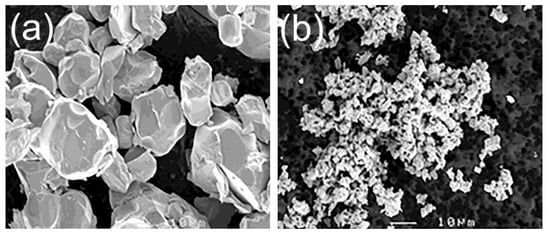
Figure 1.
SEM images of (a) Sm2Fe17 alloy powder and (b) Sm2Fe17N3 powder.
Before the consolidation of the Sm2Fe17N3 powder using the SPS method, the powder was characterized by X-ray diffraction and thermomagnetic studies. Figure 2 shows the X-ray diffraction pattern of the Sm2Fe17N3 powder, together with that of the Sm2Fe17 alloy powder. The X-ray diffraction pattern of the Sm2Fe17 alloy powder shows a typical Th2Zn17-type phase. The diffraction peaks of the Sm2Fe17 alloy powder were indexed to be the Th2Zn17-type phase, and no clear diffraction peaks of Sm-oxides and α-Fe phase were detected in the X-ray diffraction pattern. This indicates that the Sm2Fe17 alloy powder made using the diffusion reduction process consisted of the Th2Zn17-type Sm2Fe17 phase. The X-ray diffraction pattern of the Sm2Fe17N3 powder also exhibits a typical Th2Zn17-type phase. Although it is known that the Sm2Fe17N3 phase decomposes into the α-Fe and SmN phases at high temperatures [14], no diffraction peaks of these phases were noticed in the X-ray diffraction pattern. It is confirmed that the Sm2Fe17N3 powder consisted of the Sm2Fe17N3 phase.
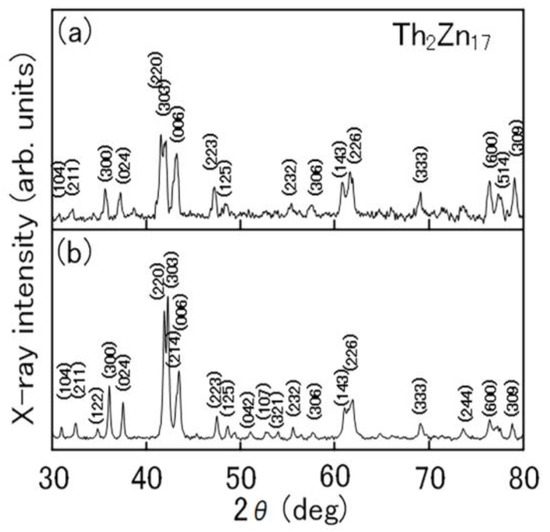
Figure 2.
X-ray diffraction patterns of (a) Sm2Fe17 alloy powder and (b) Sm2Fe17N3 powder. These diffraction peaks were indexed by the PDF cards (#00-048-1789 for Sm2Fe17 and #01-079-9758 for Sm2Fe17N3).
Figure 3 shows the thermomagnetic curve of the Sm2Fe17N3 powder, together with that of the Sm2Fe17 alloy powder. It was found that the thermomagnetic curves of the Sm2Fe17 alloy powder and the Sm2Fe17N3 powder are pretty different. The thermomagnetic curve of the Sm2Fe17 alloy powder shows a magnetic transition at around 490 K. According to the results of the X-ray diffraction studies, the Sm2Fe17 alloy powder consisted of the Th2Zn17-type Sm2Fe17 phase. Thus, the magnetic transition is believed to be the Curie temperature of the Sm2Fe17 phase. On the other hand, a large magnetic transition at around 740 K is observed in the thermomagnetic curve of the Sm2Fe17N3 powder. Since the Sm2Fe17N3 powder consisted of the Sm2Fe17N3 phase, the magnetic transition is believed to be the Curie temperature of the Sm2Fe17N3 phase. The Sm2Fe17N3 phase has a significantly high Curie temperature of 740 K, compared with the Nd2Fe14B phase in the Nd-Fe-B magnets (585 K) [23]. The observed Curie temperature of the Sm2Fe17N3 phase is consistent with the reported value [11]. No magnetic transition of the Sm2Fe17 phase was noted in the thermomagnetic curve, indicating that the Sm2Fe17N3 powder solely consisted of the Sm2Fe17N3 phase.
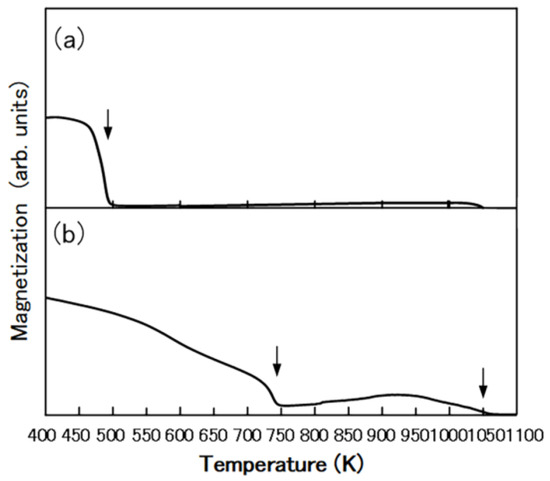
Figure 3.
Thermomagnetic curves of (a) Sm2Fe17 alloy powder and (b) Sm2Fe17N3 powder. The arrows indicate the magnetic transition temperature.
However, a slight increase in magnetization at temperatures over the Curie temperature is observed in the thermomagnetic curve of the Sm2Fe17N3 powder. This suggests that a new magnetic phase formed during the thermomagnetic measurement. The new magnetic phase is believed to be the α-Fe phase since the new magnetic phase shows the Curie temperature near 1050 K. The thermomagnetic study indicates that the Sm2Fe17N3 phase decomposes into the α-Fe and SmN phases at high temperatures over 800 K. The observed decomposition temperature is slightly lower than the reported value (873 K) [14]. In any case, it is essential to sinter the Sm2Fe17N3 powder at the lowest possible temperature because the Sm2Fe17N3 phase in Sm2Fe17N3 powder decomposes into the α-Fe and SmN phases at high temperatures.
In order to confirm the decomposition of the Sm2Fe17N3 powder, the specimen after the thermomagnetic measurement was examined using X-ray diffraction. The result is shown in Figure 4. No diffraction peaks of the Sm2Fe17N3 phase were seen in the X-ray diffraction pattern. Instead, diffraction peaks of the α-Fe and SmN phases were noticed in the X-ray diffraction pattern. This confirms that the Sm2Fe17N3 phase decomposes into the α-Fe and SmN phases during thermomagnetic measurement.
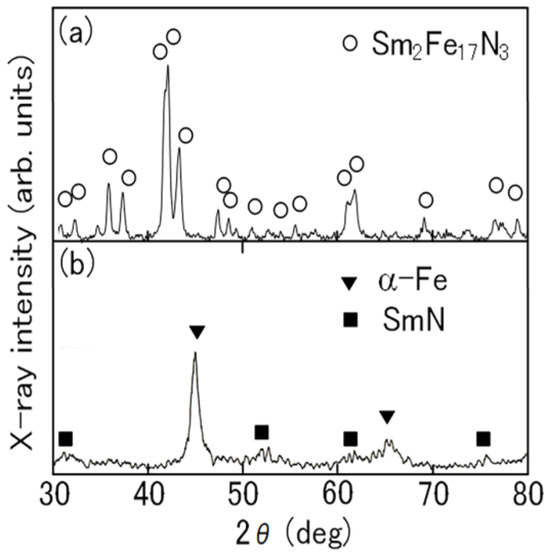
Figure 4.
X-ray diffraction patterns of (a) Sm2Fe17N3 powder and (b) the specimen after the thermomagnetic measurement.
Figure 5 shows the hysteresis loops of the Sm2Fe17 alloy powder and the Sm2Fe17N3 powder. The Sm2Fe17 alloy powder showed a narrow hysteresis loop, but the Sm2Fe17N3 powder exhibited a wide one. This indicates that the Sm2Fe17 alloy powder without nitrogenation did not display large coercivity. On the other hand, Sm2Fe17N3 powder, prepared by nitriding the Sm2Fe17 alloy powder, exhibited a large coercivity. The Sm2Fe17N3 powder exhibits a large coercivity of 12.4 kOe with a remanence of 75.3 emu/g.
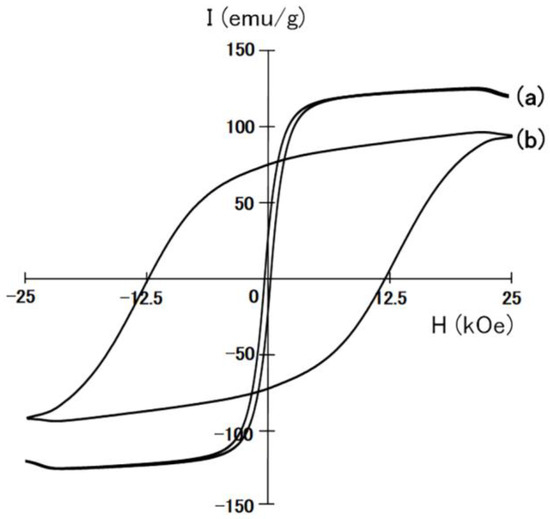
Figure 5.
Hysteresis loops of (a) Sm2Fe17 alloy powder and (b) Sm2Fe17N3 powder.
In order to confirm the magnetic anisotropy of the Sm2Fe17N3 powder, the magnetic properties of the Sm2Fe17N3 powder were measured parallel to the magnetic alignment after the Sm2Fe17N3 powder had been magnetically aligned. Figure 6 shows the hysteresis loops of the Sm2Fe17N3 powder measured parallel and perpendicular to the direction of the magnetic alignment. The respective hysteresis loops are quite different. This confirms that the Sm2Fe17N3 powder is magnetically anisotropic. The powder exhibited a high remanence of 107 emu/g and a large coercivity of 10.3 kOe when measured parallel to the direction of the magnetic alignment.
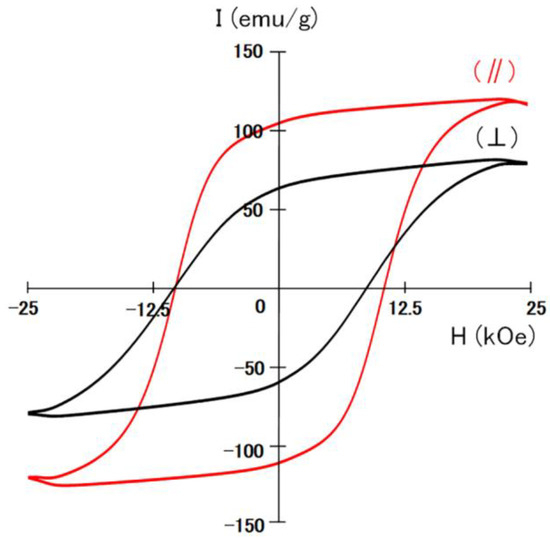
Figure 6.
Hysteresis loops of the Sm2Fe17N3 powder, measured parallel (//) and perpendicular (⊥) to the direction of the magnetic alignment.
In this study, the Sm2Fe17N3 powder was sintered into bulk magnets carried out at 673 K, far below its decomposition temperature of 800 K. Since the Sm2Fe17N3 powder is magnetically anisotropic, the Sm2Fe17N3 powder was magnetically aligned before sintering (see Figure 7). Despite the low sintering temperature, Sm2Fe17N3 bulk magnets were produced from the magnetically aligned Sm2Fe17N3 powder using the SPS method.
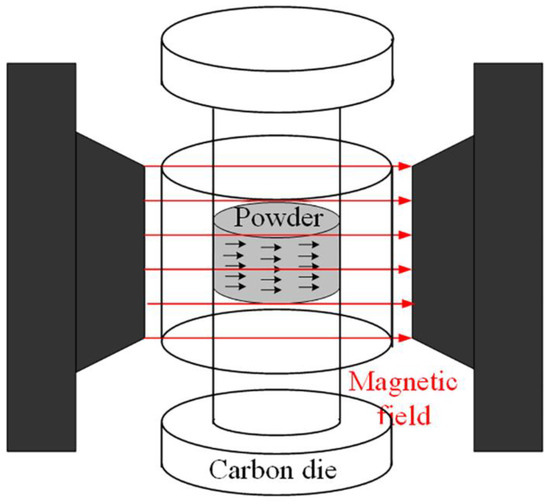
Figure 7.
Schematic diagram showing the setup for the magnetic alignment. Sm2Fe17N3 powder was poured into a carbon die and then aligned under an applied magnetic field.
Carbon contamination from carbon dies might occur in the SPS method [24]. To avoid this, the SPS experiment was done with a BN-coated carbon die, and the surface of the Sm2Fe17N3 bulk magnets was ground to remove carbon contamination before the property measurements.
A photograph of the Sm2Fe17N3 bulk magnet is shown in Figure 8. No significant cracks were found in the Sm2Fe17N3 bulk magnet. The relative density of the Sm2Fe17N3 bulk magnet was as high as 91.7% (compared with the density of the Sm2Fe17N3 powder). A higher consolidation temperature is known to promote the densification of bulk materials produced using the SPS method [25]. A further increase in the consolidation temperature may result in an increase in density, but the consolidation temperature was kept below 673 K in this study because the Sm2Fe17N3 phase in Sm2Fe17N3 powder easily decomposes into the α-Fe and SmN phases at high temperatures.
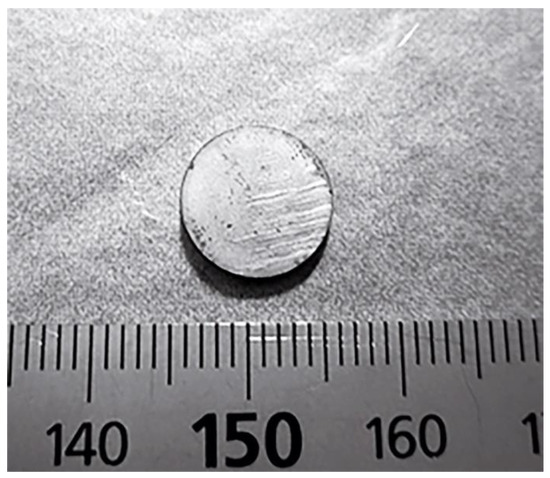
Figure 8.
A photograph of the Sm2Fe17N3 bulk magnet obtained from the Sm2Fe17N3 powder using the SPS method. The magnet was prepared at 673 K under an applied pressure of 100 MPa for 300 s using the SPS method. The magnet had a density of 7.03 g/cm3 (approximately 91.7% of the powder).
Figure 9 shows the magnetic hysteresis loops of the Sm2Fe17N3 powder and the magnet produced. The powder exhibited a high remanence of 107 emu/g and a large coercivity of 10.3 kOe. However, the magnets showed a remanence of 68.6 emu/g and a coercivity of 3.05 kOe. This indicates that the magnetic properties of the powder deteriorated during sintering. Thus, it is essential to reduce the deterioration of the magnetic properties of Sm2Fe17N3 powder during sintering.
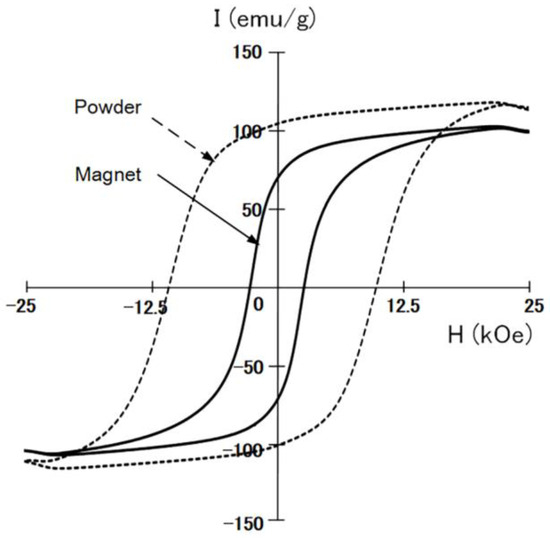
Figure 9.
Hysteresis loops of the magnetically aligned Sm2Fe17N3 powder and Sm2Fe17N3 bulk magnet, prepared at 673 K under an applied pressure of 100 MPa for 300 s using the SPS method.
As remanence is related to the magnetic alignment of the powder in the magnet, small amounts of sintering aid powder were added to the Sm2Fe17N3 powder before magnetic alignment, and its effects on the magnetic properties of the magnets were examined. In this study, various sintering aid powders, such as graphite and silica powders, were applied for this purpose. It was found that the zinc stearate powder could improve the density and magnetic alignment of the Sm2Fe17N3 powder. The effects of zinc stearate powder addition on the relative density of the Sm2Fe17N3 bulk magnets are shown in Figure 10. The relative density of the Sm2Fe17N3 bulk magnet increased from 91.7% to 95.8% as the zinc stearate content increased. Although the density of the zinc stearate powder was 1.095 g/cm3, much smaller than that of the Sm2Fe17N3 powder (7.66 g/cm3), the zinc stearate powder drastically improved the density of the Sm2Fe17N3 bulk magnet. The resultant Sm2Fe17N3 bulk magnet with small amounts of zinc stearate powder had a high density of over 95%.
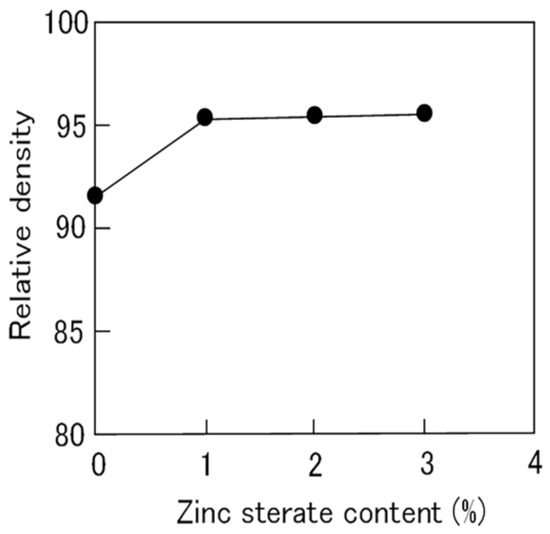
Figure 10.
Dependence of the relative density of the Sm2Fe17N3 bulk magnets on the zinc stearate content.
Figure 11 shows the effects of zinc stearate powder addition on the remanence and coercivity of the magnets. The remanence significantly increased but then decreased as the amount of zinc stearate powder was increased. In contrast, the coercivity gradually decreased as the amount of zinc stearate increased. This confirms that the addition of zinc stearate powder before magnetic alignment improved the magnetic alignment of the Sm2Fe17N3 powder.
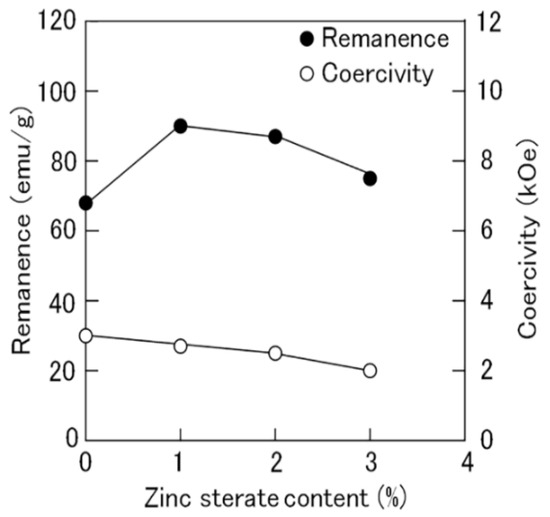
Figure 11.
Dependence of the remanence and coercivity of the Sm2Fe17N3 bulk magnets on the zinc stearate content.
Figure 12 shows the hysteresis loops of the Sm2Fe17N3 bulk magnet with 1 wt% zinc stearate powder measured parallel and perpendicular to the magnetic alignment in order to examine the magnetic anisotropy. The Sm2Fe17N3 bulk magnet is anisotropic and shows a higher remanence, 90.6 emu/g, in the parallel direction than the perpendicular direction. The magnet exhibits magnetic anisotropy due to the magnetic alignment of the Sm2Fe17N3 powder.
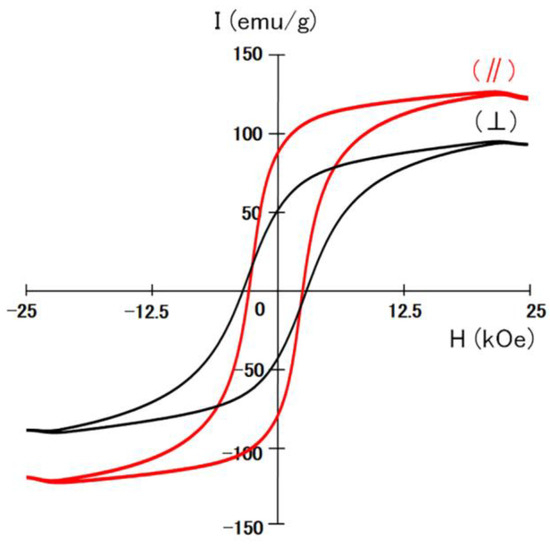
Figure 12.
Hysteresis loops of the Sm2Fe17N3 bulk magnets with 1 wt% zinc stearate powder measured parallel (//) and perpendicular (⊥) to the direction of the magnetic alignment. In the hysteresis measurements, rod-like specimens (1 × 1 × 10 mm) were cut from the magnets to avoid demagnetization correction.
As the magnetic alignment of the Sm2Fe17N3 powder is determined via the crystallographic alignment in the Sm2Fe17N3 phase, the crystallographic alignment of the Sm2Fe17N3 phase in the magnets was examined using X-ray diffraction patterns. Figure 13 shows the X-ray diffraction patterns of the magnet with 1% zinc stearate powder. As shown in the figure, X-ray diffraction patterns were measured perpendicularly and parallel to the direction of magnetic alignment. The X-ray diffraction pattern of the magnet shows a typical powder pattern of the Sm2Fe17N3 phase when measured perpendicular (⊥) to the direction of magnetic alignment. However, when measured parallel (//) to the direction of magnetic alignment, the X-ray diffraction pattern exhibited a prominent (006) peak of the Sm2Fe17N3 phase owing to the crystallographic alignment of the c-axis of the Sm2Fe17N3 phase in the magnet. This confirms that the crystallographic alignment of the Sm2Fe17N3 phase was retained in the Sm2Fe17N3 bulk magnet even after sintering using the SPS method.
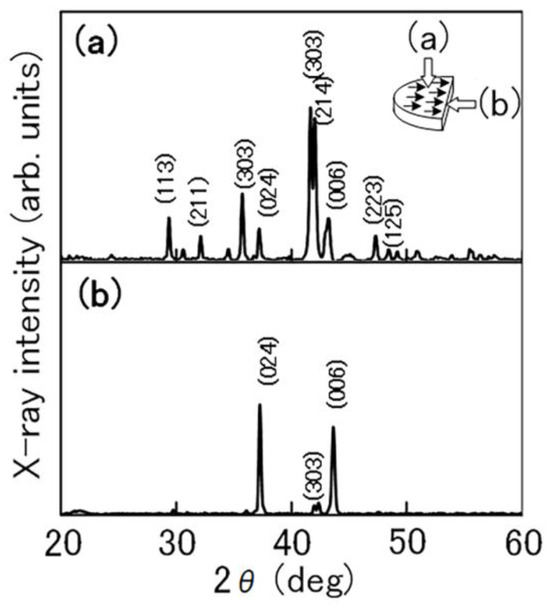
Figure 13.
X-ray diffraction patterns of the Sm2Fe17N3 bulk magnet with 1% zinc stearate powder measured (a) perpendicular to the magnetic alignment and (b) parallel to the direction of magnetic alignment. The black arrows in the Sm2Fe17N3 bulk magnet indicate the magnetic alignment of the Sm2Fe17N3 powder.
In the Nd-Fe-B magnets, the crystallographic alignment of the tetragonal Nd2Fe14B phase in the Nd-Fe-B magnets has been evaluated by the ratio, I(006)/I(0410), of the intensity of the c-axis-related peak (006) to that of the strongest peak (410) [26,27]. As the same token, the crystallographic alignment of the Sm2Fe17N3 phase can be evaluated by the ratio I(006)/I(303). The ratio of I(006)/I(303) was 0.27 for the Sm2Fe17N3 bulk magnet measured perpendicular to the direction of magnetic alignment, while the ratio of I(006)/I(303) was 10.8 for the Sm2Fe17N3 bulk magnet measured parallel to the direction of magnetic alignment. This indicates the crystallographic alignment of the Sm2Fe17N3 phase in the magnet.
As the coercivity of the magnets was improved by adding a small amount of Zn [20,21], zinc powder and 1% zinc stearate powder were added to the Sm2Fe17N3 powder before magnetic alignment. Consequently, the effects of this addition on the density and magnetic properties of the magnets were examined. Figure 14 shows the effects of zinc powder addition on the relative density of the Sm2Fe17N3 bulk magnets with 1% zinc stearate powder. Unlike in the case of the zinc stearate powder addition, the relative density of the Sm2Fe17N3 bulk magnets decreased from 95.4% to 91.5% as the zinc content increased. This indicates that the addition of zinc powder deteriorated the density of the Sm2Fe17N3 bulk magnets with 1% zinc stearate powder.
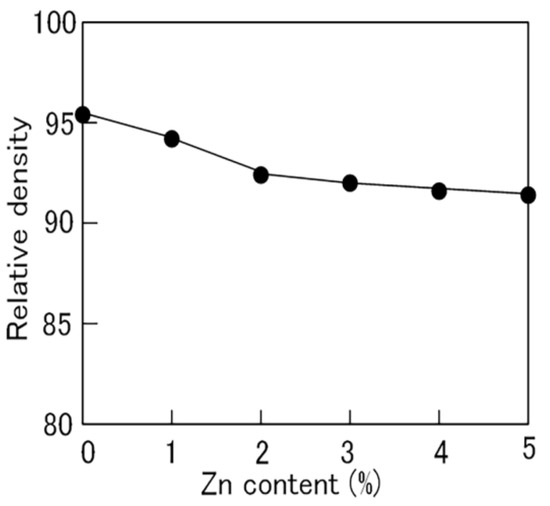
Figure 14.
Dependence of the relative density of the Sm2Fe17N3 bulk magnets with 1% zinc stearate powder on the zinc content.
Figure 15 shows the effects of zinc powder addition on the remanence and coercivity of the Sm2Fe17N3 bulk magnets. Since the 1 wt% zinc stearate powder addition effectively increased the magnetic alignment of the Sm2Fe17N3 powder, the Sm2Fe17N3 bulk magnets with 1 wt% zinc stearate powder were used as the base magnet. While the remanence slightly decreased as the amount of zinc powder increased, the coercivity considerably increased with increasing amounts. This verifies that the addition of zinc powder before the magnetic alignment improved the coercivity of the magnets.
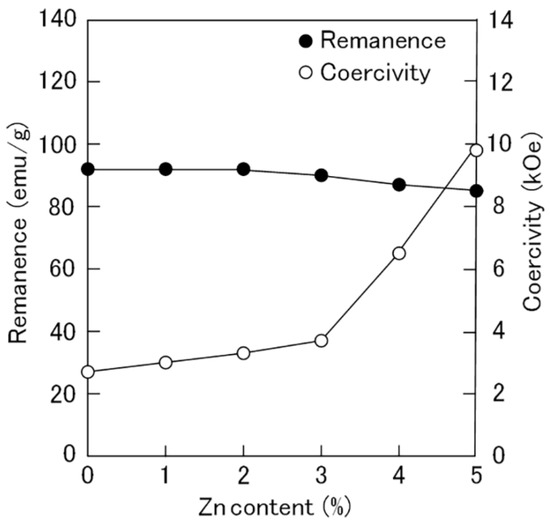
Figure 15.
Dependence of the remanence and coercivity of the Sm2Fe17N3 bulk magnets on the zinc content. Sm2Fe17N3 bulk magnets with 1 wt% zinc stearate powder were used as the base magnet.
Figure 16 shows the hysteresis loop of the magnet with 1 wt% zinc stearate and 5 wt% zinc powder. The hysteresis loop of the magnet without additives is also shown. The magnet with 1 wt% zinc stearate and 5 wt% zinc powder exhibited a wider hysteresis loop than the magnet without additives, indicating that the use of small amounts of zinc stearate powder and zinc powder increased the magnetic properties of the Sm2Fe17N3 bulk magnet. The magnet with 1 wt% zinc stearate and 5 wt% zinc powder showed a high remanence of 86.8 emu/g and a large coercivity of 9.82 kOe.

Figure 16.
Hysteresis loops of the Sm2Fe17N3 bulk magnets: (a) without additives, and (b) with 1 wt% zinc stearate and 5 wt% zinc powder. The magnets were prepared at 673 K under an applied pressure of 100 MPa for 300 s using the SPS method.
Compared with the hysteresis loop of the Sm2Fe17N3 powder (see Figure 6), the remanence and coercivity of the Sm2Fe17N3 bulk magnets with 1 wt% zinc stearate powder were slightly smaller than those of the Sm2Fe17N3 powder. Thus, further work is still necessary to improve the magnetic properties of the Sm2Fe17N3 bulk magnets.
3. Materials and Methods
Sm2Fe17 alloy powder and Sm2Fe17N3 powder, prepared by the nitrogenation of Sm2Fe17 alloy powder, were supplied by Sumitomo Metal Mining Co., Ltd. (Tokyo, Japan). The powder was poured into a BN-coated carbon die and magnetically aligned using an electromagnet before being subjected to spark plasma sintering. Sm2Fe17N3 bulk magnets were produced from the Sm2Fe17N3 powder using the SPS method under the applied pressure of 100 MPa using a spark plasma sintering apparatus (Plasman, S. S. Alloy, Hiroshima, Japan). The SPS method made the sintering in a vacuum at temperatures between 473 K and 673 K for 300 s. The specimens were cooled in the SPS chamber in a vacuum to room temperature. In order to improve the magnetic properties of the magnets, zinc stearate powder (0–3 wt%) and zinc powder (0–5 wt%) were added to the Sm2Fe17N3 powder, and the mixed powders were magnetically aligned before sintering using the SPS method.
The properties of the original powders and the magnets produced using the SPS method were examined. The morphology of the original powders was investigated using a scanning electron microscope (JSM-IT300LA, JEOL, Tokyo, Japan). The densities of the magnets were measured using the Archimedes method using an electronic balance (GR-120, AND, Tokyo, Japan). The specimens were characterized by X-ray diffraction using Cu Kα radiation using an X-ray diffractometer (MiniFlex600, Rigaku, Tokyo, Japan) and magnetic measurements by a vibrating sample magnetometer (BHV-525RSCM, Riken Denshi, Tokyo, Japan). Before magnetic hysteresis measurements of the Sm2Fe17N3 powder were performed, the powder was magnetically aligned and mixed with paraffin. To measure the magnetic properties of the Sm2Fe17N3 bulk magnets, rod-like specimens (1 × 1 × 10 mm) were measured parallel to the length direction to avoid demagnetization correction.
4. Conclusions
Although Sm2Fe17N3 powder was magnetically anisotropic and possessed high remanence and coercivity, Sm2Fe17N3 bulk magnets produced from Sm2Fe17N3 powder using the SPS method exhibited deteriorated remanence and coercivity. Herein, Sm2Fe17N3 bulk magnets were made using the SPS method with the addition of zinc stearate powder and zinc powder. It was found that the magnetic anisotropy of the magnets was enhanced upon the addition of zinc stearate powder, and the coercivity of the magnets was enhanced upon the addition of zinc powder. The Sm2Fe17N3 bulk magnets with 1 wt% zinc stearate powder and 5 wt% zinc powder exhibited a remanence of 86.8 emu/g and coercivity of 9.82 kOe.
Funding
This research received no external funding.
Data Availability Statement
The original contributions presented in the study are included in the article, further inquiries can be directed to the author.
Acknowledgments
The technical support of M. Miyauchi is acknowledged.
Conflicts of Interest
The author declares no conflicts of interest.
References
- Bailey, G.; Mancheri, N.; Van Acker, K. Sustainability of permanent rare earth magnet motors in (H)EV industry. J. Sustain. Metall. 2017, 3, 611–626. [Google Scholar] [CrossRef]
- Sreenivasulu, K.V.; Srikanth, V.V.S.S. Fascinating magnetic energy storage nanomaterials: A brief review. Recent Pat. Nanotechnol. 2017, 11, 116–122. [Google Scholar] [CrossRef]
- Yue, M.; Zhang, X.Y.; Liu, J.P. Fabrication of bulk nanostructured permanent magnets with high energy density: Challenges and approaches. Nanoscale 2017, 9, 3674–3697. [Google Scholar] [CrossRef]
- Dong, S.Z.; Li, W.; Chen, H.S.; Han, R. The status of Chinese permanent magnet industry and R & D activities. AIP Adv. 2017, 7, 056237. [Google Scholar]
- Dutta, T.; Kim, K.H.; Uchimiya, M.; Kwon, E.E.; Jeon, B.H.; Deep, A.; Yun, S.T. Global demand for rare earth resources and strategies for green mining. Environ. Res. 2016, 150, 182–190. [Google Scholar] [CrossRef] [PubMed]
- Zhou, B.; Li, Z.; Chen, C. Global potential of rare earth resources and rare earth demand from clean technologies. Minerals 2017, 7, 203. [Google Scholar] [CrossRef]
- Alonso, E.; Sherman, A.M.; Wallington, T.J.; Everson, M.P.; Field, F.R.; Roth, R.; Kirchain, R.E. Evaluating rare earth element availability: A case with revolutionary demand from clean technologies. Environ. Sci. Technol. 2012, 46, 3406–3414. [Google Scholar] [CrossRef] [PubMed]
- Kötschau, A.; Büchel, G.; Einax, J.W.; von Tümpling, W.; Merten, D. Sunflower (Helianthus annuus): Phytoextraction capacity fir heavy metals on a mining-influenced area in Thuringia, Germany. Environ. Earth Sci. 2014, 72, 2023–2031. [Google Scholar] [CrossRef]
- Miller, J.R. Forensic assessment of metal contaminated rivers in the 21st century using geochemical and isotopic traces. Minerals 2013, 3, 192–246. [Google Scholar] [CrossRef]
- Okabe, T.H. Bottlenecks in rare metal supply and the importance of recycling—A Japanese perspective. Min. Proc. Ext. Met. 2017, 126, 22–32. [Google Scholar] [CrossRef]
- Coey, J.M.D.; Sun, H. Improved magnetic properties by treatment of iron-based rare earth intermetallic compounds in ammonia. J. Magn. Magn. Mater. 1990, 87, L251–L254. [Google Scholar] [CrossRef]
- Iriyama, T.; Kobayashi, K.; Imaoka, N.; Fukuda, T.; Kato, H.; Nakagawa, Y. Effect of Nitrogen Content on Magnetic Properties of Sm2Fel7Nx (O < x < 6). IEEE Trans. Magn. 1992, 28, 2326–2331. [Google Scholar]
- Coey, J.M.D.; Stamenov, P.; Porter, S.B.; Venkatesan, M.; Zhang, R.; Iriyama, T. Sm-Fe-N revisited; remanence enhancement in melt-spun Nitroquench material. J. Magn. Magn. Mater. 2019, 480, 186–192. [Google Scholar] [CrossRef]
- Cabral, F.A.O.; Gama, S.; de Morais, E.; Sanjurjo, N.L.; Ribeiro, C.A.; Colucci, C.C. Study of thermal decomposition mechanism of Fe17Sm2N3 phase. IEEE Trans. Magn. 1996, 32, 4365–4367. [Google Scholar] [CrossRef]
- Leonowicz, M.; Kaszuwara, W.; Jezierska, E.; Januszewski, D.; Mendoza, G.; Davies, H.A.; Paszula, J. Application of the shock compaction technique for consolidation of hard magnetic powders. J. Appl. Phys. 1998, 83, 6634–6636. [Google Scholar] [CrossRef]
- Mashimo, T.; Huang, X.; Hirosawa, S.; Makita, K.; Kato, Y.; Mitsudo, S.; Motokawa, M. Magnetic properties of fully dense Sm2Fe17Nx magents prepared by shock compression. J. Magn. Magn. Mater. 2000, 210, 109–120. [Google Scholar] [CrossRef]
- Saito, T.; Fukui, M.; Takeishi, H. Sm-Fe-N bulk magnets produced by the compression shearing method. Scripta Mater. 2005, 53, 1117–1121. [Google Scholar] [CrossRef]
- Saito, T. Structures and magnetic properties of Sm-Fe-N bulk magnets produced by spark plasma sintering method. J. Mater. Res. 2007, 22, 3130–3136. [Google Scholar] [CrossRef]
- Takagi, K.; Nakayama, H.; Ozaki, K. Microstructural behavior on particle surfaces and interfaces in Sm2Fe17N3 powder compacts during low-temperature sintering. J. Magn. Magn. Mater. 2012, 324, 2336–2341. [Google Scholar] [CrossRef]
- Prabhu, D.; Sepehri-Amin, H.; Mendis, C.L.; Ohkubo, T.; Hono, K.; Sugimoto, S. Enhanced coercivity of spark plasma sintered Zn-bonded Sm–Fe–N magnets. Scr. Mater. 2012, 67, 153–156. [Google Scholar] [CrossRef]
- Matsuura, M.; Yamamoto, K.; Tezuka, N.; Sugimoto, S. Microstructural changes in high-coercivity Zn-bonded Sm-Fe-N magnets. J. Magn. Magn. Mater. 2020, 510, 166943. [Google Scholar] [CrossRef]
- Kawamoto, A.; Ishikawa, T.; Yasuda, S.; Takeya, K.; Ishikawa, K.; Iseki, T.; Ohmori, K. Sm2Fe17N3 magnet powder made by reduction and diffusion method. IEEE. Trans. Mag. 1999, 35, 3322–3324. [Google Scholar] [CrossRef]
- Sagawa, M.; Fujimura, S.; Togawa, N.; Yamamoto, H.; Matsuura, Y. New material for permanent magnets on a base of Nd and Fe. J. Appl. Phys. 1984, 55, 2083–2087. [Google Scholar] [CrossRef]
- Marinca, T.F.; Chicinaş, H.F.; Neamţu, B.V.; Popa, F.; Chicinaş, I. Reactive spark plasma sintering of mechanically activated α-Fe2O3/Fe. Ceram. Int. 2017, 43, 14281–14291. [Google Scholar] [CrossRef]
- Tokita, M. Progress of Spark Plasma Sintering (SPS) Method, Systems, Ceramics Applications and Industrialization. Ceramics 2021, 4, 160–198. [Google Scholar] [CrossRef]
- Hattori, T.; Fukamachi, N.; Goto, R.; Tezuka, N.; Sugimoto, S. Microstructural Evaluation of Nd-Fe-B Strip Cast Alloys. Mater. Trans. 2009, 50, 479–482. [Google Scholar] [CrossRef]
- Wang, L.; Chen, J.; Yue, M.; Liu, R.; Liu, W.; Zhang, D.; Zhang, J.; Zhang, P.; Ge, H. Crystallographic alignment and magnetic anisotropy in melt-spun Nd-Fe-B/α-Fe composite ribbons with different neodymium contents. J. Rare Earths 2011, 29, 471–473. [Google Scholar] [CrossRef]
Disclaimer/Publisher’s Note: The statements, opinions and data contained in all publications are solely those of the individual author(s) and contributor(s) and not of MDPI and/or the editor(s). MDPI and/or the editor(s) disclaim responsibility for any injury to people or property resulting from any ideas, methods, instructions or products referred to in the content. |
© 2024 by the author. Licensee MDPI, Basel, Switzerland. This article is an open access article distributed under the terms and conditions of the Creative Commons Attribution (CC BY) license (https://creativecommons.org/licenses/by/4.0/).